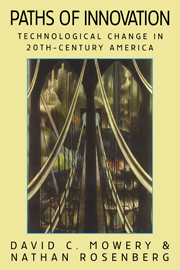1 - Introduction
Published online by Cambridge University Press: 05 June 2012
Summary
An examination of technological innovation in the 20th-century U.S. economy must naturally begin in the 19th century. An appropriate starting point is Alfred North Whitehead's observation, in Science and the Modern World, that “The greatest invention of the 19th century was the invention of the method of invention” (p. 98). Whitehead understood that this invention involved the linking of new scientific knowledge to the world of artifacts. But he also understood that this linkage was not easily achieved, because a huge gap typically exists between a scientific breakthrough and a new product or process. The sentence just quoted is well known, but equally important is the less famous observation that immediately followed it:
It is a great mistake to think that the bare scientific idea is the required invention, so that it has only to be picked up and used. An intense period of imaginative design lies between. One element in the new method is just the discovery of how to set about bridging the gap between the scientific ideas, and the ultimate product. It is a process of disciplined attack upon one difficulty after another.
Whitehead's statement serves as a valuable prolegomenon in at least two respects to this volume's discussion of technology in the 20th century. First, a distinctive feature of the 20th century was that the inventive process became powerfully institutionalized and far more systematic than it had been in the 19th century. This institutionalization of inventive activity meant that innovation proceeded in increasingly close proximity to organized research in the 20th century.
- Type
- Chapter
- Information
- Paths of InnovationTechnological Change in 20th-Century America, pp. 1 - 10Publisher: Cambridge University PressPrint publication year: 1998



